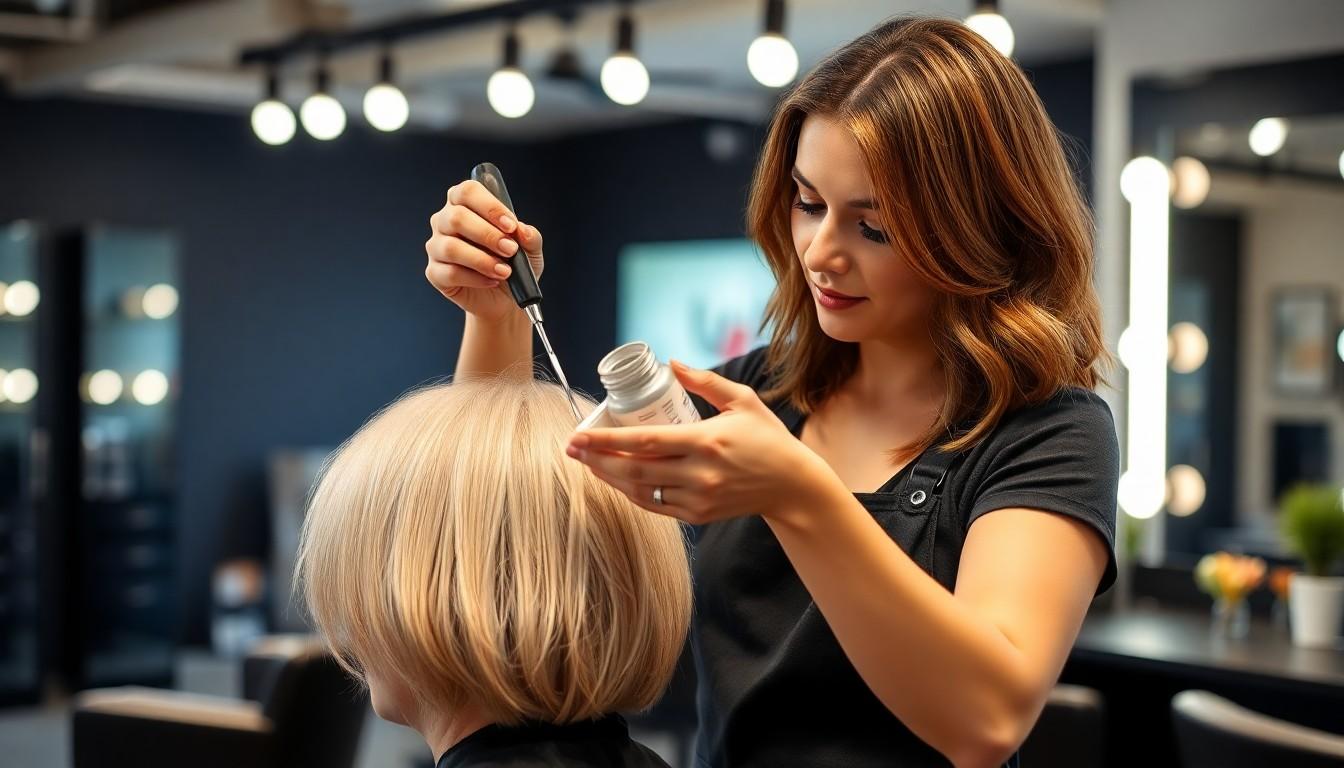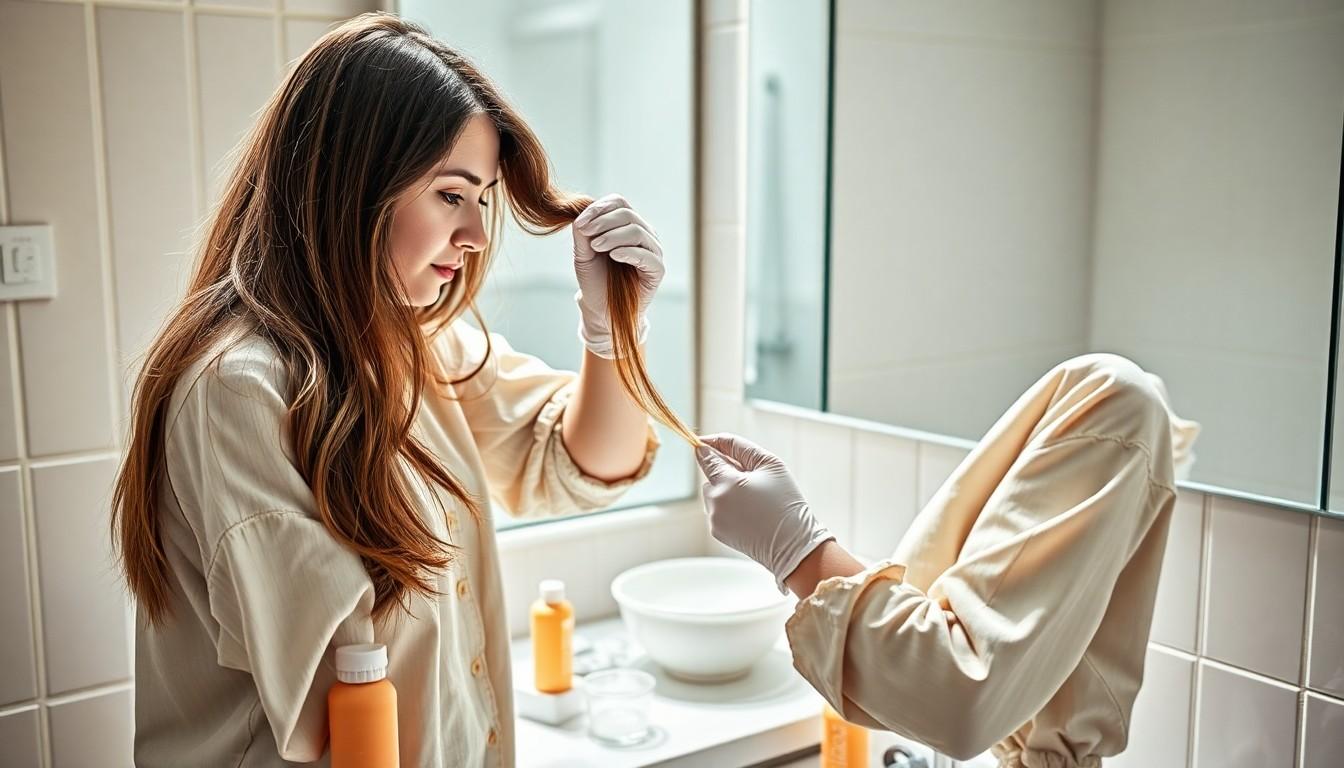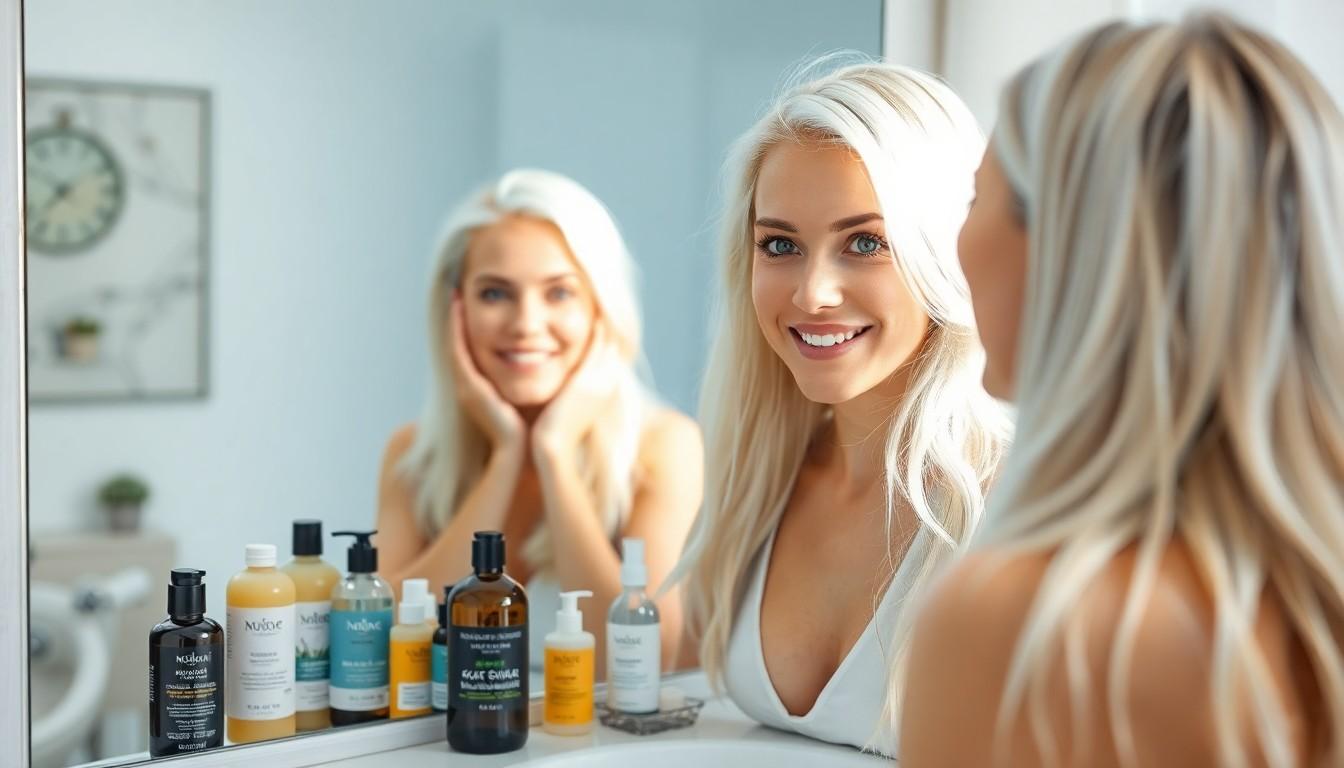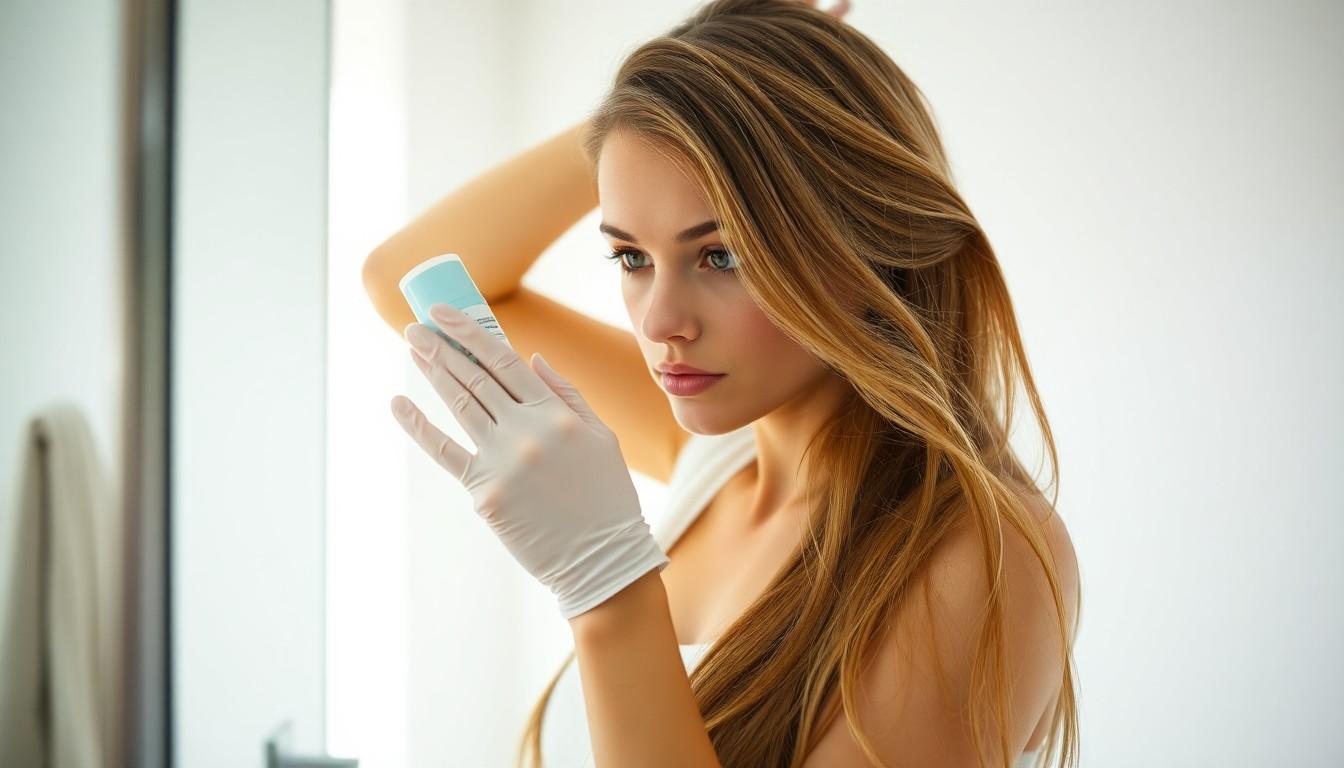Ever wondered how celebs transform their locks from dark to platinum blonde overnight? They’re using hair bleaching, a chemical process that strips color from your strands to create a lighter shade or prepare for vibrant colors that wouldn’t show up on darker hair.
We’ve seen countless transformations, from subtle highlights to bold all-over bleach jobs. This powerful technique removes natural pigment by breaking down melanin in your hair shaft with oxidizing agents like hydrogen peroxide. While it opens up a industry of color possibilities, it’s also a process that requires knowledge and care to avoid damaging your precious tresses.
What Is Hair Bleaching: A Comprehensive Guide to Lightening Your Locks
Hair bleaching is a chemical process that lifts color from your hair strands by breaking down melanin, the natural pigment that gives your hair its color. This technique allows you to dramatically lighten your natural hair color, creating a blank canvas for vibrant fashion colors or achieving that coveted platinum blonde look. Professional colorists use bleaching as a fundamental technique to transform dark hair into lighter shades that wouldn’t be possible with regular hair dye alone.
The science behind bleaching involves an oxidation reaction where hydrogen peroxide penetrates the hair shaft and dissolves existing color molecules. Your hair cuticles open during this process, allowing the bleaching agent to reach the cortex where melanin is stored. Different hair types react differently to bleaching—virgin hair typically processes more evenly than previously colored hair.
When performed correctly, bleaching can create stunning transformations, but it’s important to understand that it’s also one of the most damaging chemical processes for your hair. The same chemical reaction that removes pigment also breaks down protein bonds within your hair structure. Most bleaching products combine an alkaline agent (like ammonia) with a developer (hydrogen peroxide) at concentrations ranging from 10 to 40 volume, depending on how much lift is desired.
Timing plays a crucial role in the bleaching process—leaving bleach on too long can cause severe damage including breakage, excessive dryness, and even chemical burns on the scalp. Professional stylists carefully monitor the development process, checking every 5-10 minutes to assess the progress and condition of the hair.
After bleaching, your hair requires special care since the process leaves it more porous and vulnerable to damage. Deep conditioning treatments, protein-based products, and minimizing heat styling become essential parts of maintaining bleached hair. Many professionals recommend waiting at least 2-3 weeks between bleaching sessions to allow your hair to recover and minimize the risk of irreversible damage.
Understanding what happens during bleaching helps you make informed decisions about whether this process is right for your hair goals. We always recommend consulting with a professional colorist who can evaluate your hair’s condition and determine the safest approach to achieving your desired look.
The Science Behind Hair Bleaching: Understanding How It Works

Hair bleaching is a complex chemical process that lightens hair by removing the natural pigment from the hair shaft. Let’s explore the scientific mechanisms that make this dramatic transformation possible.
How Bleach Removes Your Natural Hair Color
Bleaching works primarily by targeting melanin, the natural pigment responsible for your hair color. Your hair contains two types of melanin: eumelanin, which creates black and brown colors, and pheomelanin, which produces red hues. The bleaching process systematically breaks down these melanin molecules through oxidation, effectively stripping away your natural color.
Strong oxidizing agents like hydrogen peroxide (H₂O₂) and persulfate salts form the backbone of hair bleach formulations. When mixed with an alkaline developer, these chemicals release oxygen radicals that penetrate deep into the hair shaft. These powerful radicals attack and fragment the melanin molecules, rendering them colorless.
The alkaline environment created by ingredients such as ammonium hydroxide or ethanolamine plays a crucial role in the process. By raising the pH level of your hair, these alkaline substances cause the cuticle layers to swell and open, allowing the hydrogen peroxide to penetrate more effectively into the cortex where melanin resides.
The Chemical Reaction That Creates Lighter Hair
The oxidation process begins when hydrogen peroxide enters the hair cortex and reacts with your melanin pigments. This reaction progressively breaks down the melanin through oxidation, gradually lightening your hair color as more pigment molecules are transformed into colorless compounds.
During bleaching, the powerful oxidants also cleave the disulphide bonds in keratin, the primary protein giving your hair its strength and structure. This bond breakage makes your hair more porous and receptive to the bleaching agents, facilitating more effective decolorization. Scientific studies have shown that bleaching can break 15-20% of your hair’s protein bands, explaining why bleached hair often feels more fragile.
Hair lightening occurs in stages, following a predictable color progression from your natural shade to red, then orange, yellow, and finally pale yellow or platinum blonde. The exact stage you reach depends on factors like processing time, bleach concentration, and your starting hair color.
Several variables influence your bleaching results, including the duration of application and concentration of oxidizing agents. Longer processing times and higher peroxide concentrations will yield lighter results but significantly increase the risk of structural damage to your hair. The science explains why professional colorists carefully monitor the bleaching process – they’re balancing the chemical reaction needed for color removal against the potential for compromising hair integrity.
Different Types of Hair Bleaching Products and Techniques

Hair bleaching products come in various formulations, each designed for exact applications and results. Understanding these differences can help you choose the right option for your hair transformation journey.
Powder Bleach vs. Cream Bleach
Powder bleach offers superior lightening power and is typically the go-to choice for professional stylists. This potent formula contains persulfate salts that, when mixed with a developer (hydrogen peroxide), effectively open the hair cuticle and break down melanin in the cortex. Professional colorists often prefer powder bleach for its versatility and strength when important lightening is required. Mixing ratios can be adjusted based on the desired result, making it highly customizable for different hair types and conditions.
Cream bleach provides a more user-friendly alternative with its pre-mixed formulation of bleaching agents and developer. The consistency of cream bleach makes application smoother and less messy than powder versions, which is ideal for at-home users. Additional moisturizing ingredients are commonly found in cream bleach formulations, offering some protection against excessive damage during the bleaching process. These products typically cause less damage to hair but may not achieve the same level of lightening as their powder counterparts, especially for those with naturally dark hair colors.
On-Scalp vs. Off-Scalp Applications
On-scalp application involves placing bleach directly on hair at the scalp level for full-head lightening. This technique delivers uniform results and is essential when attempting to achieve an all-over lighter shade. Direct scalp contact requires careful monitoring to prevent chemical burns, irritation, or over-processing that could damage both hair and skin. We recommend following processing times strictly and performing a patch test before attempting full-scale on-scalp bleaching treatments.
Off-scalp applications like highlighting and balayage involve painting bleach onto selected sections of hair away from the scalp. This selective approach gives colorists precise control over which strands receive lightening treatment, creating dimension and custom effects. Reducing direct scalp contact minimizes the risk of irritation while still allowing for dramatic color transformations. Techniques such as foiling, free-hand painting, or using a cap for highlights fall under this category and are excellent options for those wanting to experiment with lighter tones without committing to all-over bleaching.
The Step-by-Step Process of Professional Hair Bleaching

Achieving that perfect blonde transformation isn’t as simple as slapping on some bleach. Professional hair bleaching follows a methodical process designed to maximize results while minimizing damage.
Consultation and Hair Assessment
Professional colorists always begin with a thorough consultation to evaluate your hair’s condition before any bleach touches your strands. During this crucial assessment, they’ll examine your natural color level, hair porosity, and any previous chemical treatments that might affect the bleaching process. Your stylist needs this information to determine if your hair can safely withstand the bleaching process and to predict potential outcomes. This evaluation helps them customize the formula strength, application technique, and processing time specifically for your hair type. Remember that honesty about your hair history is essential during this phase, as undisclosed previous treatments can lead to unexpected and potentially damaging results.
Application Techniques and Processing Time
Stylists prepare the bleaching mixture by combining persulfate-based bleaching powder with an appropriate developer (hydrogen peroxide) to create a consistent paste. Application methods vary based on the desired effect, with options ranging from full head coverage to more artistic techniques like balayage or foiling for dimensional results. The bleach is applied systematically, often starting at the mid-lengths where processing occurs more slowly, then moving to the ends, and finally to the roots which process fastest due to scalp heat.
Processing time typically ranges from 30-50 minutes depending on your starting color, desired result, and hair condition. Throughout this period, your stylist will check your hair approximately every 10 minutes to monitor the lightening progress and prevent over-processing. You might experience a slight tingling or burning sensation during application, which is generally normal but should never become intensely painful. Hair lightens through various stages – moving from dark to reddish tones, then to yellow, pale yellow, and potentially platinum blonde depending on your hair’s natural pigmentation. After achieving the desired level of lift, the bleach is thoroughly rinsed out, and a toner may be applied to neutralize unwanted brassy or yellow tones and achieve your perfect shade.
DIY Hair Bleaching: What You Need to Know Before Trying at Home

While professional results often yield the safest hair transformations, many people opt to bleach their hair at home. Before you embark on this chemical journey, it’s crucial to understand what you’re getting into and how to prepare properly.
Essential Tools and Products for Home Bleaching
Successfully bleaching your hair at home requires gathering the right supplies before you begin. A quality bleach kit containing bleaching powder with persulfates forms the foundation of your DIY arsenal. The developer (hydrogen peroxide) comes in various strengths, with different volumes (10, 20, etc.) determining how dramatically your hair will lighten. Protective gloves are non-negotiable to prevent chemical burns and irritation on your hands during application. An old shirt or plastic cape will shield your clothing from permanent bleach stains that won’t wash out. Pre and post-bleach care products like gentle shampoo and deep conditioner help minimize damage throughout the process. Many DIY bleachers also need toner to neutralize brassy tones after lightening, especially when aiming for cooler blonde shades. Sectioning clips and a non-metal mixing bowl complete your toolkit, ensuring even application and proper product preparation.
Common Mistakes to Avoid When Bleaching Your Own Hair
Choosing the incorrect developer volume ranks among the most damaging mistakes in DIY bleaching, potentially causing severe breakage or inadequate lightening. Many home bleachers fail to perform crucial strand tests first, risking unexpected color results across their entire head instead of just testing a small section. Processing time errors happen frequently—either removing the bleach too soon before reaching desired lightness or leaving it on too long, which significantly compromises hair integrity. Neglecting protective gear leads to skin irritation and potentially serious chemical reactions that could have been easily prevented. Instructions exist for a reason, yet many DIYers improvise rather than following the exact directions included with their bleach kit. Attempting to bleach already damaged or previously colored hair without proper assessment creates a perfect storm for hair disasters. People often expect dramatic results in one session, when darker hair typically requires multiple carefully spaced bleaching sessions to reach lighter shades safely. Skipping the assessment of your starting hair condition before bleaching sets you up for unexpected outcomes, as different hair types and textures react uniquely to the chemical process.
Potential Risks and Damage: The Dark Side of Going Light

While bleaching can transform your hair dramatically, it’s important to understand the potential risks involved. The chemicals used in the bleaching process can cause important damage to both your scalp and hair structure if not handled properly.
Chemical Burns and Scalp Irritation
Hair bleaching products contain powerful chemicals like hydrogen peroxide and persulfate salts that can be harsh on your skin. These aggressive bleaching agents often cause irritation when they come in contact with your scalp. Many people experience redness, itching, and burning sensations during or after the bleaching process. In more severe cases, these chemicals can lead to actual chemical burns on the scalp, resulting in pain, blistering, and even scabbing. The risk increases significantly when higher concentrations of hydrogen peroxide are used or when the product is left on the scalp for too long. Professional colorists know how to minimize these risks, but even in expert hands, some level of irritation may still occur due to the inherently caustic nature of bleaching agents.
Long-Term Effects on Hair Structure and Health
Bleaching does more than just lighten your hair—it fundamentally alters its structure. The process works by penetrating the hair shaft and breaking down keratin, which inevitably weakens your hair over time. Your hair cuticle (the protective outer layer) lifts during bleaching, leaving your strands vulnerable to further damage and moisture loss. Natural oils that keep your hair soft and manageable are stripped away, resulting in dry, brittle strands that snap easily when brushed or styled.
Hair porosity changes dramatically after bleaching, with your strands becoming more porous and hence absorbing too much moisture. This increased porosity leads to swelling of the hair shaft and creates a cycle of damage that’s difficult to reverse. Color stability becomes another concern, as bleached hair tends to fade faster and often develops unwanted brassy or yellow tones that require frequent toning treatments.
The unpredictable nature of bleaching can also result in uneven color distribution across your head, particularly if you have previously colored or damaged hair. Multiple bleaching sessions may be necessary to achieve your desired lightness, and each session compounds the damage to your hair structure. Even with the most careful application techniques and high-quality products, repeated bleaching will eventually compromise your hair’s integrity and may lead to extreme breakage or hair loss in severe cases.
Aftercare: How to Maintain and Nourish Bleached Hair

Bleached hair requires special attention to restore moisture and strength lost during the chemical process. Proper aftercare is essential to maintain your newly lightened locks and prevent further damage.
Specialized Products for Bleached Hair
Bleached hair demands exact care products designed to address its unique needs. Sulfate-free shampoos offer a gentler cleansing experience that preserves both color and moisture, preventing unnecessary stripping of your hair’s natural oils. Color-protecting conditioners work effectively to lock in both moisture and color molecules, significantly reducing fading and combating the dryness commonly associated with bleached hair. Hydrating masks containing powerful ingredients like keratin, argan oil, or coconut oil should become a regular part of your hair care routine to restore moisture and strength. Products with shea butter can help seal the cuticle and protect your bleached strands from environmental damage. Regular use of these specialized products creates a protective barrier that maintains your hair’s health and vibrancy between salon visits.
Protein Treatments and Deep Conditioning Routines
Protein treatments serve as a critical component in repairing bleached hair’s compromised structure. These specialized formulas contain proteins like keratin and collagen that fill in gaps in the hair shaft damaged during the bleaching process. Implementing a deep conditioning routine should become non-negotiable after bleaching, with experts recommending sessions once or twice weekly for optimal results. Most deep conditioning masks work best when left on for 15-30 minutes, allowing the nourishing ingredients to penetrate deeply into the hair shaft. Avoiding heat styling tools minimizes additional stress on already vulnerable hair, but when necessary, always apply a heat protectant first. Regular trims help eliminate damaged ends before they travel up the hair shaft, maintaining your bleached hair’s overall health. Moisturizing products containing argan oil, coconut oil, or shea butter effectively lock in hydration and provide a protective layer for bleached strands.
When to Choose Professional Bleaching vs. At-Home Options

Professional Bleaching
Professional bleaching offers important advantages for those pursuing dramatic color transformations. Experts recommend visiting a salon when attempting to make substantial changes, especially when going from dark to very light shades. Professional colorists can navigate the multiple stages of lightening with precision, ensuring your hair remains as healthy as possible throughout the process.
Previously colored hair requires professional attention due to the complexities involved in working with existing dye molecules. Colorists possess the training to properly assess your hair’s condition and history, creating customized treatment plans that prevent damage while achieving your desired results.
The customization factor cannot be overstated when considering professional services. Salon experts adjust bleach formulations specifically for your hair type, thickness, and current condition, minimizing potential damage while maximizing results. Their extensive training also enables them to handle any unexpected reactions or complications that might arise during the bleaching process.
At-Home Options
At-home bleaching kits work well for those seeking minor adjustments or maintaining already lightened hair. These more affordable options allow you to refresh your color without the expense of salon visits, making them practical for simple touch-ups.
Simple lightening projects that only require lifting your hair a few shades can often be accomplished with DIY kits. Virgin hair (never previously colored) typically responds more predictably to at-home treatments than processed hair. Before committing to full application, performing a strand test helps prevent unwanted results or adverse reactions.
Cost considerations make at-home options appealing for those on a budget. While professional bleaching might cost hundreds of dollars depending on your location and hair length, DIY kits typically range from $10-30 for a complete treatment.
Factors to Consider When Deciding
Hair condition serves as the primary determining factor when choosing between professional and at-home bleaching. Damaged, fragile, or previously processed hair benefits significantly from professional care to prevent further deterioration of hair integrity.
Time investment differs considerably between these options. Professional sessions might require several hours at the salon but often achieve desired results in fewer visits. DIY approaches typically demand multiple applications spread over several days or weeks to safely reach lighter shades without excessive damage.
Safety concerns should guide your decision, as professionals have been trained to monitor the bleaching process continuously. They can identify when to rinse the product to prevent over-processing, chemical burns, or breakage—risks that increase significantly with at-home applications.
Results consistency tends to be more reliable with professional services. Salons use higher-quality products specifically formulated for different hair types and concerns, whereas consumer products must be formulated to work reasonably well for a wide range of users, potentially compromising effectiveness for some hair types.
Bleaching Different Hair Types and Colors: What to Expect

The hair bleaching process can vary dramatically depending on your natural hair color and texture. Understanding these differences will help you set realistic expectations and prepare for the best possible outcome.
Bleaching Dark Hair vs. Light Hair
Dark hair requires significantly more processing when bleaching compared to naturally lighter shades. The higher concentration of melanin in dark hair means you’ll need stronger bleaching agents, specifically powder-bleach formulations, to achieve noticeable lightening results. Multiple bleaching sessions are often necessary for dark hair to reach pale blonde shades, with appropriate recovery time between treatments. This staged approach helps minimize damage while allowing you to gradually lighten without compromising hair integrity.
Light hair typically responds much faster to bleaching treatments since there’s less pigment to remove. Naturally blonde or light brown hair can often achieve platinum or pale blonde results in a single session. Even with lighter starting shades, we recommend following product instructions precisely to prevent overprocessing. The reduced resistance to bleach means light hair can quickly move past your target shade if not carefully monitored during processing.
Considerations for Different Hair Textures
Fine or damaged hair demands extra caution during the bleaching process. These hair types have less structural integrity to begin with, making them particularly vulnerable to chemical damage. Pre-bleach treatments containing bond-building ingredients can help protect fine strands during processing. Gentler bleaching formulas with lower developer volumes (20 volume instead of 30 or 40) should be used on fine or previously damaged hair. Processing time must be carefully monitored, as fine hair typically lightens much faster than other textures.
Coarse or thick hair presents different challenges when bleaching. The density and diameter of coarse hair strands make it more resistant to bleaching agents, often requiring longer processing times to achieve desired results. Penetrating the thicker hair shaft completely may necessitate stronger bleach formulations, though this increases potential damage. Application techniques for thick hair should ensure even saturation, as uneven application can lead to patchy results. Sectioning hair thoroughly before applying bleach becomes especially important with coarse textures to guarantee consistent color results throughout.
Modern Alternatives to Traditional Hair Bleaching

Looking for gentler ways to lighten your locks? Traditional bleaching isn’t your only option anymore. Today’s hair lightening industry offers several alternatives that can help you achieve a lighter look with potentially less damage. Here are five modern approaches to consider:
1. Balayage and Highlights
Balayage and highlights provide a more targeted approach to hair lightening than full-head bleaching. These techniques involve painting or weaving lightener onto exact sections of hair, creating dimension while leaving other parts untouched. By treating only selected strands, these methods significantly reduce overall damage to your hair. Many clients prefer these techniques for their natural-looking results that grow out more gracefully than traditional all-over bleaching.
2. Semi-Permanent and Demi-Permanent Lighteners
Semi-permanent and demi-permanent lighteners offer a gentler alternative to traditional bleach products. These formulations contain lower concentrations of hydrogen peroxide or alternative lightening agents, making them less harsh on your hair structure. They’re perfect for those wanting to go just a few shades lighter without committing to the intense chemical process of traditional bleaching. The reduced chemical intensity helps maintain better hair integrity while still achieving noticeable lightening effects.
3. Natural Lightening Methods
Natural lightening approaches have gained popularity among those seeking chemical-free alternatives. Sun exposure can gradually lighten hair, though results tend to be less controlled than chemical methods. Other natural options include applying lemon juice, honey, or chamomile treatments to hair before sun exposure. While these methods work more slowly and produce more subtle results than chemical bleaching, they offer a gentler path to lighter hair for those concerned about chemical exposure.
4. At-Home Lightening Kits with Gentler Formulas
Modern at-home lightening kits have evolved to address concerns about hair damage. Many newer products feature gentler formulations enhanced with conditioning ingredients to help protect hair during the lightening process. These kits often include bond-protecting additives similar to those used in professional treatments. Manufacturers have responded to consumer demand by creating products that balance effective lightening power with enhanced hair protection.
5. Professional Lightening Treatments with Bond Protectors
Professional salons now offer advanced lightening treatments that incorporate cutting-edge technology to minimize damage. These services frequently include bond-repairing products like Olaplex that help maintain hair integrity during the chemical process. Professional colorists can customize these treatments based on your hair type, condition, and goals, using techniques that protect the hair while still achieving important lightening. The addition of bond-protecting treatments represents a major advancement in professional hair lightening technology.
Each of these alternatives offers unique benefits depending on your desired results, hair condition, and comfort level with chemical processes. While traditional bleaching remains effective for dramatic transformations, these modern approaches provide options for those seeking gentler paths to lighter hair.
Conclusion: Is Hair Bleaching Right for You?
Hair bleaching offers groundbreaking possibilities but requires careful consideration of your hair’s health condition and your desired outcome. The chemical process that creates that perfect blank canvas for vibrant colors comes with both rewards and risks.
We’ve explored how bleaching works by breaking down melanin through oxidation and the importance of proper technique whether done professionally or at home. From powder bleach to cream formulations each option serves different needs and skill levels.
Today’s market also offers gentler alternatives like balayage selective highlighting and bond-protecting treatments for those concerned about damage. Whatever path you choose remember that proper aftercare is essential for maintaining your bleached hair’s health and vibrancy.
The perfect blonde may require commitment but with the right approach and realistic expectations you can achieve stunning results while keeping your hair’s integrity intact.
Frequently Asked Questions
What is hair bleaching?
Hair bleaching is a chemical process that removes natural pigment from hair by breaking down melanin using oxidizing agents like hydrogen peroxide. It creates a blank canvas for vibrant colors or achieving lighter shades that wouldn’t be possible with regular hair dye alone. The process involves an oxidation reaction where chemicals penetrate the hair shaft and dissolve existing color molecules.
How does hair bleaching work scientifically?
Bleaching works by targeting melanin (hair’s natural pigment) through a chemical reaction. Oxidizing agents like hydrogen peroxide and persulfate salts mix with alkaline developers to release oxygen radicals. These penetrate the hair shaft and fragment melanin molecules, making them colorless. The alkaline environment causes hair cuticles to swell, allowing deeper penetration of the bleach solution.
Is hair bleaching damaging to hair?
Yes, bleaching is one of the most damaging chemical processes for hair. It breaks down protein bonds and cleaves disulphide bonds in keratin, making hair more porous and fragile. The oxidation process not only lightens hair but also compromises its structural integrity, leading to increased brittleness and potential breakage if not properly managed.
What are the stages of hair lightening during bleaching?
Hair lightening occurs in predictable stages, progressing from natural color to red, then orange, yellow, and finally pale yellow or platinum blonde. The progression depends on processing time and bleach concentration. Each stage represents the gradual breakdown of different melanin molecules, with darker hair requiring more time to reach lighter stages.
What’s the difference between powder bleach and cream bleach?
Powder bleach offers superior lightening power and versatility, making it favored by professionals. It can achieve more dramatic lifts but requires expert mixing. Cream bleach is more user-friendly with added moisturizing ingredients, making it better for at-home use. It provides more consistent application but typically doesn’t lift as dramatically as powder formulations.
Can I bleach my hair at home safely?
DIY bleaching is possible but requires careful preparation and research. You’ll need quality bleach, appropriate developer, protective gloves, and proper aftercare products. Common mistakes include choosing wrong developer strength, skipping strand tests, and not assessing hair condition beforehand. Professional services are recommended for major color transformations, especially from dark to very light shades.
What aftercare do bleached hair need?
Bleached hair requires specialized aftercare to restore moisture and strength. Use sulfate-free shampoos, color-protecting conditioners, and regular protein treatments. Deep conditioning masks should be applied weekly, and heat styling should be minimized. Purple shampoo can help maintain tone, while leave-in conditioners provide ongoing protection against environmental damage.
How does natural hair color affect the bleaching process?
Natural hair color significantly impacts bleaching results. Dark hair requires stronger bleaching agents and often multiple sessions to achieve desired lightness. Light hair responds faster to bleaching. Fine or damaged hair needs gentler formulas and careful monitoring, while coarse or thick hair may need stronger formulations and longer processing times for even results.
What are the risks of hair bleaching?
Risks include chemical burns and scalp irritation (redness, itching, pain), weakened hair structure, increased porosity, and moisture loss leading to brittleness. Repeated bleaching can cause uneven color, extreme breakage, and potential hair loss. Improper application may result in hot roots (brighter roots than ends) or patchy results.
Are there gentler alternatives to traditional bleaching?
Yes, gentler alternatives include balayage and highlights for targeted lightening, semi-permanent lighteners for less harsh results, natural lightening methods using lemon juice or chamomile, specialized at-home kits with conditioning ingredients, and professional treatments incorporating bond protectors like Olaplex that maintain hair integrity while lightening.














